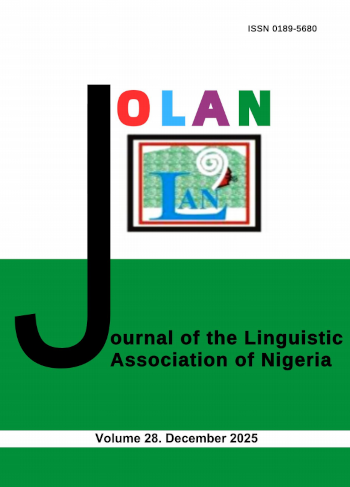On Raising: A Study of English and Yoruba
Keywords:
Raising structures, noun phrases, Adjacency Condition, second language situation, Yoruba, EnglishAbstract
This paper examined raising in Yoruba with a view to spelling out its manifestation in Yoruba, while contrasting it with English. This was to reveal the peculiarities of raising structures in Yoruba in relation to English, and their implications for learners of both languages in a second language situation. Chomsky’s Principles and Parameters Theory served as the theoretical framework. Yoruba sentences were obtained from naturally-occurring discourses among native speakers of Yoruba. The acceptability of the structures was validated by twenty native speakers of Yoruba in Oyo, Oyo State, Nigeria through oral interview. Secondary data were obtained from textbooks in both languages under study. Theoretically, raising is induced by (raising) adjectives and verbs. It could be to subject or object position. However, contrary to the common subject-to-subject raising that English structures justify, Yoruba permits object-to-subject raising. Also, Yoruba has raising verbs, like English. In Yoruba, raising can occur without necessarily being triggered by adjectives or verbs because the verbs in such constructions lack the features of typical raising verbs. Besides, object raising in Yoruba is cyclic, as moved elements land temporarily at the SPEC position of the subordinate clause, in fulfilment of adjacency condition.
References
Adesola. O. 2005. Pronouns and null operators- A-bar dependencies and relations in Yoruba. Ph.D Dissertation Rutgers University. New Jersey, USA.
Ajongolo, T. 1997. NP movement in Yorùbá. M.A. Thesis. Dept. of Linguistics. University of Ibadan, Nigeria.
Ayinde, A. 2017. NP-Movement in English and Yoruba. M A Thesis. Department of English. University of Ibadan, Nigeria.
Baltin, M. 2001. A- movement. The handbook of contemporary syntactic theory. M. Baltin and C. Collins. Eds. USA: Blackwell Publishers.
Bamgbose, A. 1984. Yoruba metalanguage: Ede-iperi Yoruba: a glossary of English Yoruba technical terms in language, literature and methodology. Lagos: Nigeria Educational Research Council
Black, A. 1998. A step by step introduction to government and binding theory of syntax. Notes on Linguistics. 73:5-12.
Buring, D. 2005. Binding theory. New York: Cambridge University Press.
Carnie, A. 2006. Syntax: a generative introduction. 3rd ed. Malden: Blackwell Publishing.
Chomsky, N. 1970. Remarks on nominalization. In R. Jacobs and E. Rosenbaum (eds.) Readings in English transformational grammar. Waltham. Mass.: Ginn 184-221.
Chomsky, N.1982.Some concepts and consequences of the theory of Government and Binding. Chicago: MIT Press.
Chomsky, N. 1991. Some notes on the economy of derivation. In R. Freidin (ed.) Principles and parameters in comparative grammar. Cambridge, Mass.: MIT Press. 417-54.
Chomsky, N. 1995. The minimalist program. Cambridge, MA: MIT Press.
Cook, V. J. and Newson, M. 2010. Chomsky’s Universal Grammar: an introduction Malden: Blackwell Publishing.
Freidin, R. 1970. Interpretive semantics and the syntax of English complement constructions Ph.D dissertation, Indiana University
Graddol, D. 1997. The future of English? A guide to forecasting the popularity of the English language in the 21st century (Vol. 29). The British council. Retrieved Feb. 28, 2017, from https://
doanbangoc. files. wordpress.com/the future-of-English.pdf
Haegeman, L. 1994. Introduction to government and binding. Oxford; Blackwell.
Kiparsky, C. and Kiparsky P.. 1970. Fact, in Bierswisch and Heidolph, eds.
Lasnik, H. 1972. Analyses of negation in English. PhD. Thesis. Dept. of Foreign Literature and Linguistics. MIT.
Lakoff, R. 1968. Abstract syntax and Latin complementation. Cambridge . Mass. MIT Press
Lamidi, M.T. 2013. Aspects of Chomskyan grammar. Ibadan: University Press PLC.
McCawley, J. 1970. English a VSO Language. Language 46: 286-99
Polinsky, M. 2013. Raising and control. The Cambridge handbook of generative syntax. M, den Dicken. Ed. Cambridge: Cambridge University Press. 2-40
Postal, P. 1974. Onraising. Cambridge, MA: MIT Press.
Poutsma, H. 1928. A grammar of late modern English. Part I, second ed. Groningen: D. Noordhoff
Radford, A. 1988. Transformational grammar: A first course. Cambridge: Cambridge University.
Robyn, M. 2012. Argument Intervention in the Acquisition of A-movement. Ph.D dissertation.UCLA
Rosenbaum, P. 1967. The grammar of English predicate complement constructions. Cambridge Mass: MIT Press
Ross, J. 1967. Constraints on variables in syntax. Ph.D dissertation, MIT. Reproduced by the Indians University Linguistics club
Schneider, G. 1998. Introduction to government and binding. Englishes Seminar der Universitat Zurich
Silva, G. 1973. On infinitival complements: a cross-linguistic study. Ph.D dissertation. UCLA
Shopen, T. 1972. A generative theory ellipsis, a consideration of the linguistic of silence. Ph.D dissertation. UCLA
Sunday, A. B. 2004. Compound and phrasal stress(es) in educated Yoruba English. M. A. Project. Dept. of English, University of Ibadan.
Sunday A.B. 2010. The Suprasegmentals of bilingual Nigerian adult aphasics. SKASE Journal of Theoretical Linguistics. Vol. 7. No. 2: 39-66.
Sunday A.B. 2013. The segmentals of bilingual Nigerian adult Broca’s aphasics. International Journal of Applied Linguistics & English Literature. Vol. 2. No.3:83-94.
Williamson, K, and Blench, R. M. 2000. Niger-Congo. In African languages: An introduction. Heine, B. and Nurse, D. (Eds.) Cambridge, UK: Cambridge University Press. 11-42.














